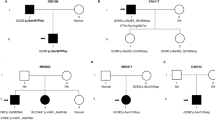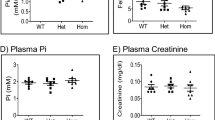Abstract
Familial hypocalciuric hypercalcemia (FHH) is an autosomal dominant syndrome of unknown aetiology characterized by lifelong elevation in serum calcium concentration and low urinary calcium excretion. These features suggest that the causal gene is important for maintenance of extracellular calcium homeostasis by the parathyroid gland and kidney. To identify the chromosomal location of FHH gene(s), we clinically evaluated 114 individuals in four unrelated affected families and performed linkage analyses. The disease gene mapped to the long arm of chromosome 3 in each family (combined maximum multipoint lod score = 20.67). We suggest that this is the predominant FHH locus and anticipate that identification of the FHH gene will improve our understanding of the molecular basis for physiologic and pathologic regulation of calcium.
This is a preview of subscription content, access via your institution
Access options
Subscribe to this journal
Receive 12 print issues and online access
$209.00 per year
only $17.42 per issue
Buy this article
- Purchase on Springer Link
- Instant access to full article PDF
Prices may be subject to local taxes which are calculated during checkout
Similar content being viewed by others
References
Marx, S.J. et al. Am. J. Med. 65, 235–242 (1978).
Foley, T.P., Harrison, H.C., Arnaud, C.D. & Harrison, H.E. J. Pediatrics 81, 1060–1067 (1972).
Marx, S.J. et al. Medicine 60, 397–412 (1981).
Law, W.M. & Heath, H. Ann. int. Med. 102, 511–519 (1985).
Brown, E.M. Physiol. Revs. 71, 371–411 (1991).
Attie, M.D. et al. J. clin. Invest. 72, 667–676, 1983.
Menko, F.H. et al. Hum. Genet. 67, 452–454, (1984).
Heath, H.III. et al. J. Bone Min. Res. 176S (1991).
Lyons, T.J. et al. Br. J. Surg. 73, 188–192 (1986).
Toss, G., Arnqvist, H., Larsson, L. & Nilsson, O. J. int. Med. 225, 201–206 (1989).
Nussbaum, S.R. et al. Clin. Chem. 33, 1364–1367 (1987).
Doak, S., Jordan, S., McWilliam, P. & Humphries, P. Nuc. Acid Res. 19, 4017 (1991).
Weber, J.L., May, P.E., Patterson, D., Drabkin, H. & Killary, A. M. Nucl. Acid Res. 18, 4635 (1990).
Grangvist, M., Xiang, K., Seino, M., Fukumoto, X. & Bell, G.I. Nucl. Acid Res. 19, 4017 (1991).
Weber, J.L. & May, P.Z. Am. J. hum. Genet. 44, 388–396. (1989).
Donis-Keller, H. et al. Cell 51, 319–337 (1987).
McAlpine, P.J. et al. Cytogenet. Cell Genets 46, 659 (1987).
Lamhonah, A.-M. et al. Proc. Natl. Acad. Sci. U.S.A. 83, 4864–4868 (1986).
Garcia, D. et al. Proc. 8th Intl Congress of Hum. Genet. 352 (1991).
Farrar, G.J. et al. Genomics 8, 35–40 (1990).
Levy, E.R., Rack, K., Buckle, V.J., Genoma Data Base version 4.2 (The Johns Hopkins University, Baltimore, Maryland).
Sparkes, R.S., Klisak, I., Kaufman, D., Mohandas, T., Tobin, A.J. & McGinnnis, J.F. Curr. Eye Res. 5, 797–798 (1986).
Tonoki, H., Narahara, K., Matsumoto, T., Niikawa, N. Cytogenet. Cell Genet. 56, (2) 103–104 (1991).
Nemeth, E.F. & Scarpa, A. FEBS Lett. 203, 15–19 (1986).
Chin, H.M., Kozak, C.A., Kim, H.L., Mock, B. & McBride, O.W. Genomics 11, 914–919 (1991).
Catterall, W.A., Seagar, M.J. & Takahashi, M. J. biol. Chem. 263, 3535–3538 (1988).
Anderson, M.A. & Gusella, J.F. In Vitro 20, 856–858 (1984).
Richards, E.J. In Current Protocols in Molecular Biology (eds Ausubel, R.M. et al.) (Greene Publishing, New York, 1987).
Lathrop, G.M., Lalouel, J.M., Julier, C. & Ott, J. Proc. natn. Acad. Sci. U.S.A. 81, 3443–3446 (1984).
Ott, J. Analysis of human linkage. (Johns Hopkins University Press, Baltimore, 1983).
Author information
Authors and Affiliations
Rights and permissions
About this article
Cite this article
Chou, YH., Brown, E., Levi, T. et al. The gene responsible for familial hypocalciuric hypercalcemia maps to chromosome 3q in four unrelated families. Nat Genet 1, 295–300 (1992). https://doi.org/10.1038/ng0792-295
Received:
Accepted:
Issue Date:
DOI: https://doi.org/10.1038/ng0792-295
This article is cited by
-
Clinical profile of juvenile primary hyperparathyroidism: a prospective study
Endocrine (2018)
-
Comparison of human chromosome 19q13 and syntenic region on mouse chromosome 7 reveals absence, in man, of 11.6 Mb containing four mouse calcium-sensing receptor-related sequences: relevance to familial benign hypocalciuric hypercalcaemia type 3
European Journal of Human Genetics (2010)
-
A novel mutation of the calcium sensing receptor gene is associated with chronic pancreatitis in a family with heterozygous SPINK1 mutations
BMC Gastroenterology (2003)



